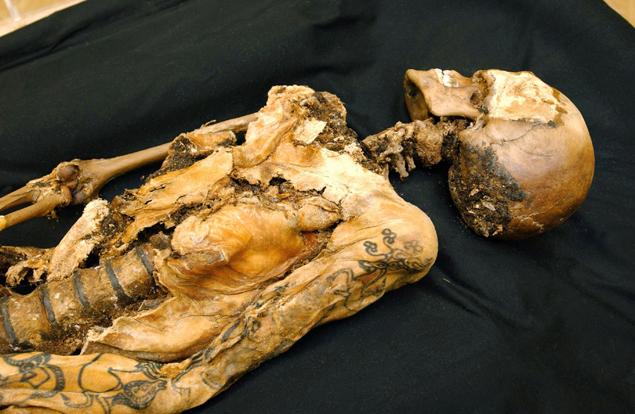Introduction to the Siberian Ice Maiden
The “Siberian Ice Maiden,” discovered in 1993 in the Altai Mountains of Siberia, is one of the most remarkable archaeological finds of the 20th century. This 2,500-year-old mummy, preserved in pristine conditions by the region’s permafrost, provides a rare glimpse into the world of the Scythians, a nomadic culture that once dominated the Eurasian steppes. With her intricate tattoos and an array of burial artifacts, the Ice Maiden offers valuable insights into ancient customs, artistry, and beliefs.
A Peek Beneath the Ice: Who Was the Ice Maiden?
Archaeologists believe the Ice Maiden was a woman of high status, potentially a priestess or a member of the Scythian elite. Her burial chamber, carved into the frozen ground, contained not only her well-preserved body but also lavish artifacts that reflected her elevated social position. These included:
- Elaborate clothing: Her garments were made from fine silk and wool, featuring intricate embroidery.
- A ceremonial headdress: Adorned with golden antlers, the headdress hints at her potential religious or ceremonial role.
- Burial goods: Items such as a small wooden table and food offerings suggested beliefs in an afterlife where these items would be needed.
The Tattoo: A Masterpiece of Scythian Artistry
The most fascinating discovery on the Ice Maiden’s body was her tattoo: a stylized image of a Scythian deer. This was not merely decorative. The tattoo holds significant cultural and symbolic meaning:
- Symbolism: The Scythian deer, with its exaggerated antlers and flowing lines, is believed to represent spiritual or mythical ideals, possibly serving as a protective emblem.
- Status Marker: Tattoos like hers were likely a marker of status, indicating her elite position within society.
- Artistic Tradition: The sophisticated design demonstrates the advanced artistic skills of the Scythians, who are known for their intricate animal motifs.
Such tattoos also provide evidence of a long-standing tradition of body art in human history, dating back millennia and continuing in various forms across cultures today.

The Scythian Context: Life on the Steppes
The Scythians were a nomadic people who thrived between the 9th and 2nd centuries BCE. Their culture was deeply intertwined with the natural world, which is reflected in their art, rituals, and way of life. Key features of Scythian society include:
- Nomadic Lifestyle: They lived on horseback, moving across the vast steppes and developing a strong connection with animals.
- Artistic Legacy: Scythian art is famous for its “animal style,” where creatures are depicted in dynamic, flowing forms.
- Spiritual Beliefs: Their burial practices and artifacts suggest a belief in an afterlife and the spiritual significance of nature.
The Ice Maiden’s burial is a prime example of these cultural traits. The items found with her paint a vivid picture of the Scythians’ respect for their dead and their desire to equip them for the journey into the afterlife.
The Science of Preservation: Why the Ice Maiden Survived
The permafrost of Siberia played a crucial role in preserving the Ice Maiden. The cold, stable environment prevented the decomposition of organic material, allowing archaeologists to recover not only her mummified body but also her clothing, tattoos, and burial artifacts.
- Significance for Research: This preservation has enabled scientists to analyze her DNA, diet, and even her final moments.
- Global Impact: The discovery has contributed to our understanding of how climate and geography can safeguard ancient treasures.

Cultural Significance and Controversy
The discovery of the Ice Maiden has sparked debate, particularly among the indigenous Altai people. Many see her as an ancestral figure and have called for her return to the burial site to respect traditional beliefs. This raises important questions about the balance between scientific discovery and cultural heritage.
Conclusion: A Legacy Preserved in Ice
The Siberian Ice Maiden is far more than an archaeological curiosity. She is a gateway to understanding the Scythians’ complex and vibrant world. From her symbolic tattoos to the extraordinary artifacts buried with her, she offers an unparalleled view of life—and death—on the ancient steppes.
As modern science continues to uncover her secrets, the Ice Maiden reminds us of the enduring connection between humanity, art, and the natural world, even across thousands of years.
